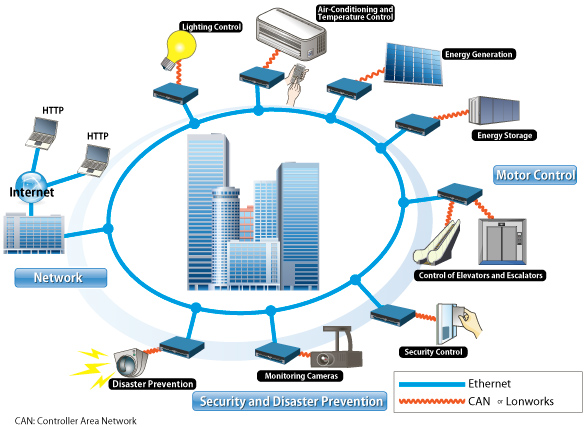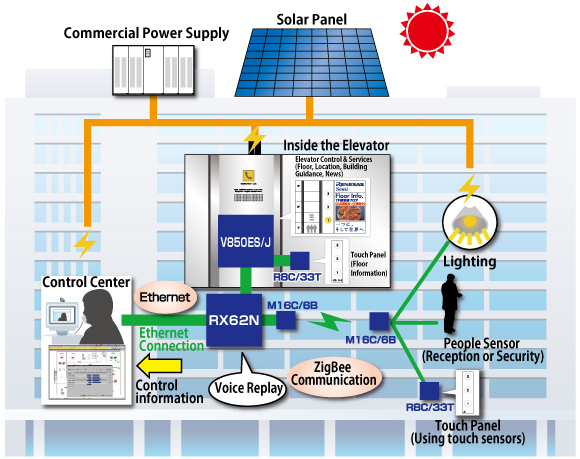Comprehensive and efficient facility management functions characterize the smart buildings that are a vital part of smart grids. These buildings use a digital network to connect and control a wide variety of equipment—including elevators, solar panels, and an extensive set of sensors that detect temperature, lighting, human presence, and other parameters. Electronic real-time control systems deliver enhanced operational efficiency and reduced carbon emissions, while lowering management costs. In particular, electrical usage efficiency is greatly improved by precisely controlling lighting, air conditioning, and other electrical systems, and by allowing flexible operation of power supplies. The 'whole-building' control systems are essential for enabling smart grids to realize efficient energy generation, energy savings, and energy storage. High-performance microcontrollers (MCUs), like the devices Renesas supplies in volume, are required to connect the different types of equipment to the networks in smart, 'green' buildings. The networked chips make possible the achievement of efficient energy usage. This article describes typical applications and spotlights representative chips in the broad range of MCUs we offer.
Linking building equipment and systems together to orchestrate more efficient operation
Smart buildings are needed to support the smart grids that are designed to promote efficient energy generation, produce energy savings, and implement energy-storage methods that decrease peak loads on power-distribution systems. Whether newly designed or retrofitted, these buildings are centrally controlled by means of a digital network connected to devices and systems that monitor and respond to the changing conditions of a diverse array of operational factors.
As Figure 1 shows, components affected include air-conditioning systems; lighting systems; solar energy generators; power-supply systems; various sensors for detecting temperature, humidity, power usage, and other conditions; and monitoring cameras that scan for dangerous conditions and help maintain security. Centralized control of these and other elements promotes the efficient use of energy—for example, by turning off lights and air conditioning in unoccupied areas, and by switching to appropriate alternate power sources when solar energy generation becomes insufficient.
In most cases, a smart building uses an Ethernet backbone with bridges to Controller Area Network (CAN) and/or LonWorks interfaces. Multiple building controllers in the structure are required to implement these bridges, while high-performance endpoint microcontrollers (MCUs) are used to transmit sensor information over the network, receive command signals from the network, and compute the appropriate control signals. Additionally, digital devices form communication bridges between the Ethernet and the other interface(s) used by the building's equipment and systems.
Being a leading global supplier of microcontrollers, Renesas develops, manufactures and sells to customers worldwide a multitude of different MCUs that are ideal for implementing the reliable real-time control systems that make smart buildings 'smart'—and therefore, energy efficient. For new smart-building designs, some of our many semiconductor solutions are the devices in the RX62N family, as well as those in the V850ES/J, M16C and R8C families. These products are highlighted in the typical application illustrated in Figure 2.

Example of applications in a smart building.
Applying the RX62N’s fast data transmission to design excellent building controllers
Renesas RX62N MCUs provide the computing capability, high-speed communication functionality and device reliability needed for designing superior building controllers. Devices in this product line can transmit IEEE-802.3 frames, provide an Ethernet controller supporting 10-Mbit/s and 100-Mbit/s communication, and incorporate other general-purpose interfaces that enable easy bridging between different networking protocols.
RX62N microcontrollers deliver high-speed data transfers, too. Each of these chips has two main internal buses—a CPU bus and a DMAC bus—so that the CPU and DMAC can function in parallel and data transfers can proceed even when the CPU bus is busy. Because the Ethernet-controller DMAC allows the device to process data from the Ethernet without loading its CPU, degradations of protocol processing or application execution are avoided.
Smart-building designs that incorporate operating terminals can achieve enhanced ease-of-use with graphical displays and touch panels. RX62N MCUs facilitate such user-friendly features because they integrate an external DMAC (EXDMAC) that conducts external-bus transfers independently of internal-bus operation. Therefore, these chips can generate TFT LCD display screens without overburdening the CPU. The devices also allow the use of lower-cost terminals because the user interfaces being displayed can be generated without the use of an external LCD controller.
MCUs in the RX62N family deliver robust connectivity and strong analog interface functionality. In particular, the MCUs' internal 8-channel A/D converter supports both 10-bit and 12-bit operation, so the terminal user can select the optimum sensor sampling rate and data precision. These microcontrollers implement superlative sensor control and can connect to a wide variety of sensors—including those used for measuring temperature, humidity, position, acceleration, illumination and more.
Supporting smart-building sustainability with the V850ES/Jx3-E low-power MCU
The Renesas V850ES/Jx3-E MCU, like its RX62N counterparts, is an excellent solution for many sustainability-type applications in smart buildings. In Figure 2, for instance, this device is shown controlling an elevator. The chip includes an internal Ethernet controller and supports 10/100Base-T communication. Running at speeds up to 50 MHz, it achieves processing performance up to 103 MIPS. Due to Its large memory capacity—as much as 512 KB of flash memory and 124 KB of RAM—the V850ES/Jx3-E MCU can be used for network applications without having to connect to external memory. Its low power consumption makes it an ideal solution for lighting controllers and other applications in which large quantities of the same types of products and equipment must be installed within a building.
Providing M16C chips for general-purpose control, communication and interface tasks
Renesas' popular M16C microcontrollers can be used for a wide span of applications within smart buildings, such as the subsystem communication and lighting control functions shown in Figure 2. These MCUs have high ROM code efficiency that reduces memory requirements and they incorporate numerous EMI/EMS protections for enhanced application reliability Offering high-speed processing, and power-saving operation, M16C chips contain numerous integrated peripherals that reduce system complexity and cost.
Supplying R8C/3xT MCUs for easy designs of highly reliable touch-panel and operating keys
As Figure 2 illustrates, user-friendly touch-panel operation can easily be added to the building's functions with designs that use R8C/3xT MCUs, devices that have a built-in capacitive touch-detection circuitry. These special-purpose MCUs directly address and resolve two design hurdles that engineers creating capacitive touch panels face: (1) the panels consume more power than mechanical units, and (2) they have a higher vulnerability to noise, which complicates adjustments of the display's touch sensitivity.
Specifically, the R8C/3xT is a single-chip solution that combines circuitry from our R8C-family MCUs with a widely used capacitive touch-detection IC developed by Omron. In standby mode, the MCU's CPU remains idle, while only the detection circuitry is active, periodically checking for a user's touch on the control panel. The CPU activates when a touch is detected. This method of operation considerably shortens the CPU's running time compared to MCUs with conventional designs, and as a result, it lowers the chip's overall power consumption.
To help engineers overcome the design issue of sensitivity adjustment, the R8C/3xT comes with a PC application program called 'Workbench'. This app makes it easy to adjust the detection circuit's digital-filter parameter values, greatly simplifying the work required to achieve the correct balance between noise exclusion and touch sensitivity. Moreover, it allows panel operation to be monitored in real time.

Typical energy-saving management solution for “green” building.
Continuously developing solutions for growth markets, especially applications that improve the global environment
The wide and expanding range of microcontroller solutions Renesas has developed suits smart-building applications around the world because (1) it encompasses appropriate performance levels and feature sets at attractive price points, and (2) it boasts a comprehensive array of support products and services that accelerate the system development cycle. We strive to help customers create new embedded control systems rapidly and manufacture them in volume. Further, customers benefit from the additional hardware, software and technical support provided by an extensive international community of technology-partner companies.
Clearly, 'green' buildings, smart grids, and other eco-friendly trends are primary markets for Renasas as we move forward. They offer opportunities for sales growth for us and our customers, and they also enable us to play important roles in improving the planet's environment. We are working constantly to develop improved design solutions not only for smart buildings, but also for smart homes. Future application-specific devices and optimally configured smart-building-oriented products will contribute to environmental sustainability by facilitating the implementation of systems that better support efficient energy generation, additional energy use reductions, and advances in energy storage.
Advertisement
Learn more about Renesas Electronics America





